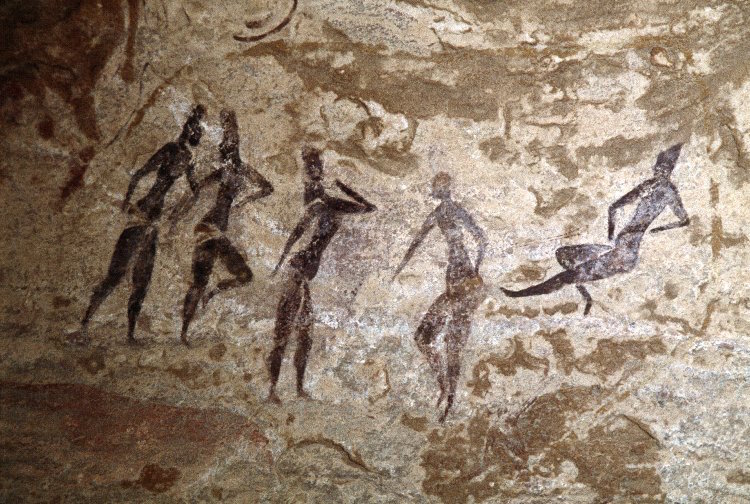Giants and beings of unknown origin were recorded by the ancients
Found in many regions of the world, cave paintings have been a valuable source of information for understanding the lifestyle and beliefs of early humans. Some depict scenarios that are fairly simple to understand, such as men hunting or entire families in a village.

The cave paintings discovered on the Tassili n’Ajjer plateau in southern Algeria, are a major conundrum for scholars.
They sketched what they observed, assuming that ancient humans did not have the ability to imagine such art: “One of the images appears to portray an extraterrestrial pursuing human being towards an oval object, comparable to a small spaceship.”
To see up close what many consider to be the world’s finest museum of prehistoric art, visitors must journey to the parched plains of the Sahara desert. Specifically in southern Algeria, 700 metres above sea level, is the Tassili plateau.
It is feasible to reach one of the earliest sources of information on ancient terrestrial life by traversing many cliffs. Years of wear and tear, as well as the strong forces of nature, have rendered the road nearly inaccessible. Rock formations that resemble enormous stone sentinels may be seen.
It is precisely in this location where caverns and more caves, with around 1,500 cave paintings dating from 10 to 15 thousand years, come into play.
They are thought to have been created by humans who lived on the site throughout the Upper Paleolithic and Neolithic periods.
Some paintings make sense, but others are enthralling, leaving you to ponder the true meaning for hours on end. First and foremost, everything discovered in this remote location supports what was originally thought about the Sahara Desert: this location was once bustling with life. A diverse range of plant and animal species coexisted in this area, as well as in many other parts of Africa and the world.
The patterns on ledges and rocks appear to imply that flowers, olive groves, cypresses, and other species grew in a fertile and vibrant environment. Furthermore, the current wildlife included antelopes, lions, ostriches, elephants, and rivers teeming with crocodiles. Unquestionably, a totally different scenario than what is now occurring in the Sahara.
Similarly, human beings can be seen in their daily activities in over a thousand primitive depictions discovered in Tassili.
Men hunting, swimming, and farming, as well as other routine activities in an archaic civilization. Nothing out of the ordinary for numerous experts and scholars who have visited this genuine book of stones.
Now, there are certain fascinating aspects that even the most sceptical brains can detect. To begin with, the tonality of the paintings is considerably more diverse than that which was typically used at that period. The rock art scenes from the same time period are not as vibrant as those seen here.

The images that appear to portray creatures wearing helmets and diving suits, quite similar to current astronauts, are the most stunning and difficult to accept. Furthermore, other pictures depict humanoids with enormous round heads and excessively large limbs.

Everything appears to imply that these strange and perplexing artworks show that creatures from other worlds visited our planet in the distant past. It is thought that primitive humans were unable to envision this type of art. Instead, they just sketched what they saw, which became part of their memories.

This entire collection of cave paintings might be the oldest evidence of a meeting between mankind and creatures from other worlds. In fact, one of the photos appears to depict a group of aliens escorting several people towards an oval object like a small spaceship.
Some experts who have visited the site believe that the early painters witnessed something unusual and left pictorial proof of it. These depictions of creatures with huge round heads are of ‘Tassili’s gods of unknown origin.’
